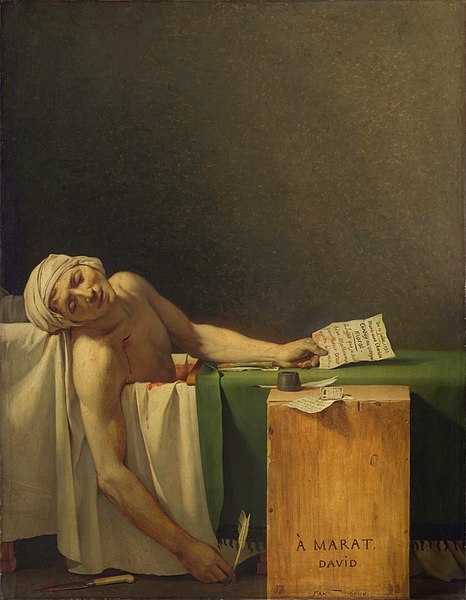Beautiful Paintings of Terrible People: The Death of Marat
7:00 AM |
| Jacques-Louis David, The Death of Marat, 1801-1805 |
Beautiful Paintings of Terrible People
By LIBBY ROHR
By LIBBY ROHR
For this post, the terrible person is twofold. Both Jean-Paul Marat, as the revolutionary martyr pictured here, and Jacques-Louis David, the painter, were intelligent, talented people gone bad. Picture it, just a few years before the French Revolution, the tension is mounting in the wake of the shockingly successful American Revolution due to french support. In Paris, he was just coming into the light of success after a series of acclaimed essays on philosophy, science, and government. January of 1789, the year the revolution began in Paris, Marat was still under the impression the monarchy might still be able to solve their country’s problems. However, by September, Marat’s writing began took a sharp new turn, shifting towards the movement of the revolution that would soon sweep his city as he took on the new role as editor of L’Ami du Peuple, a revolutionary newspaper. Marat grew more and more radical, drifting towards the more dangerous side of the revolution and befriending Maximilien Robespierre along the way while supporting the Jacobin faction of the revolution. With his newspaper he became a leader in inciting propaganda, stirring up the people to a point where he was nearly arrested upwards of three separate times. However, his fame began to grow to the point that it overruled those arrest warrants and, though a rogue, he was able to continue to work and write in paris. He worked particularly hard to bring down the Girondin revolutionary faction and to fuel the fires of violence. He became one of the most dangerous men of the early revolution from his place in the bathtub (he had a skin condition soothed only by hot baths) scrawling out scathing articles. On July 13th, 1793, he agreed to meet with a beautiful young girl, Charlotte Corday, claiming she wished protection from the violence, but upon stepping into the room where he was bathing, Corday pulled out a knife from under her dress, revealed her continued support to the Girondins, and stabbed Marat to death. As blood filled his bathtub, she ran, and without meaning to, his posthumous image as a martyr became an even stronger tally on the side of the Jacobins, who, led by Robespierre, would take this momentum and begin the Reign of Terror, arguably Paris’ most unjust and dangerous time.
But as I said, Marat is not the only one to blame. David, the painter, had taken on a similarly vocal role in the revolution and was a close personal friend to Marat. He, like Marat, rose to success shortly before the revolution began, painting beautiful neoclassical scenes like his famous Oath of the Horatii, which were widely popular in the increasingly revolutionary climate in Paris. When the revolution did break out, David, always the hidden radical, was quick to jump to the side of the Jacobins, entranced by their vision of a utopian Paris. He, too, became a master of propaganda, painting, rather than writing, his incredibly convincing pleas to the people. David himself had visited Marat in that very bathing room the day before his murder, and upon hearing what had happened, knew exactly what had to be done. David immediately jumped in to paint his friend as the martyr for the cause. The Jacobin Christ figure. An image so emotional and haunting it practically fueled the Jacobin rise to power and the subsequent horrors.
But how could one not be moved by this portrait. The Death of Marat is unquestionably stirring. A man in his most vulnerable state, sitting naked in a bath in his own home, lays draped over the edge, head lolling back, defeated. His pen remains in his right hand while the other clutches the introduction letter from Ms. Corday, now smeared with his blood. A shadow has been cast across that side of the painting, as if to show his final breaths have just left his body. Directly behind his gaunt, quickly paling face, is a crimson pool, giving a horrifying image to represent the violence of his brutal murder. The white linen of purity surrounds Marat, right to his turban-like hat, framing his face almost like a fabric halo. Marat’s round visage and slightly parted lips are childlike and innocent. If you didn’t understand the mechanics of the revolution, you’d see this and come away telling a story of slaughter of the pure and well meaning. Of senseless violence robbing a poor man of his precious life. Of renewed support for the Jacobin side of the revolution.
That’s what qualifies Marat and David for my list of terrible people. They might not have been the literal hands to drop the guillotine, but the two of them are at least significantly responsible for putting Robespierre and his Committee of Public Safety in a position to do so. Their sheer ability to create such moving emotional propaganda through their arts made these two master manipulators. At the time they likely believed they were doing what was best for their country. Don’t we all? The difference is, with a few strongly worded articles and a violent tribute to a lost friend, these two became responsible for the paranoid executions of 1400 people. Clearly a stunning work, it’s easy to get lost in the glowing tenebrism of this painting, just make sure that when all’s said and done, it’s something you can pull yourself out of.
0 comments